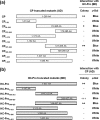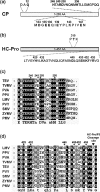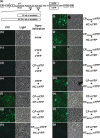Mutational analysis of interaction between coat protein and helper component-proteinase of Soybean mosaic virus involved in aphid transmission
- PMID: 20447275
- PMCID: PMC6640531
- DOI: 10.1111/j.1364-3703.2009.00603.x
Mutational analysis of interaction between coat protein and helper component-proteinase of Soybean mosaic virus involved in aphid transmission
Abstract
Soybean mosaic virus (SMV), a member of the genus Potyvirus, is transmitted by aphids in a non-persistent manner. It has been well documented that the helper component-proteinase (HC-Pro) plays a role as a 'bridge' between virion particles and aphid stylets in the aphid transmission of potyviruses. Several motifs, including the KITC and PTK motifs on HC-Pro and the DAG motif on the coat protein (CP), have been found to be involved in aphid transmission. Previously, we have shown strong interaction between SMV CP and HC-Pro in a yeast two-hybrid system (YTHS). In this report, we further analysed this CP-HC-Pro interaction based on YTHS and an in vivo binding assay to identify crucial amino acid residues for this interaction. Through this genetic approach, we identified two additional amino acid residues (H256 on CP and R455 on HC-Pro), as well as G12 on the DAG motif, crucial for the CP-HC-Pro interaction. We introduced mutations into the identified residues using an SMV infectious clone and showed that these mutations affected the efficiency of aphid transmission of SMV. We also investigated the involvement of the PTK and DAG motifs in the CP-HC-Pro interaction and aphid transmission of SMV. Our results support the concept that physical interaction between CP and HC-Pro is important for potyviral aphid transmission. Based on the combination of our current results with previous findings, the possibility that aphid transmission may be regulated by more complex molecular interactions than the simple involvement of HC-Pro as a bridge is discussed.
Figures




Similar articles
-
Role of soybean mosaic virus-encoded proteins in seed and aphid transmission in soybean.Phytopathology. 2013 Sep;103(9):941-8. doi: 10.1094/PHYTO-09-12-0248-R. Phytopathology. 2013. PMID: 23927427
-
Potyvirus aphid transmission requires helper component and homologous coat protein for maximal efficiency.Arch Virol. 1998;143(11):2159-72. doi: 10.1007/s007050050449. Arch Virol. 1998. PMID: 9856099
-
Engineering aphid transmission of foxtail mosaic virus in the presence of potyvirus helper component proteinase through coat protein modifications.J Gen Virol. 2023 Apr;104(4). doi: 10.1099/jgv.0.001844. J Gen Virol. 2023. PMID: 37053090
-
Aphid Transmission of Potyvirus: The Largest Plant-Infecting RNA Virus Genus.Viruses. 2020 Jul 17;12(7):773. doi: 10.3390/v12070773. Viruses. 2020. PMID: 32708998 Free PMC article. Review.
-
Enhancing Capsid Proteins Capacity in Plant Virus-Vector Interactions and Virus Transmission.Cells. 2021 Jan 7;10(1):90. doi: 10.3390/cells10010090. Cells. 2021. PMID: 33430410 Free PMC article. Review.
Cited by
-
Helper virus-independent transcription and multimerization of a satellite RNA associated with cucumber mosaic virus.J Virol. 2012 May;86(9):4823-32. doi: 10.1128/JVI.00018-12. Epub 2012 Feb 29. J Virol. 2012. PMID: 22379080 Free PMC article.
-
Pepper Mottle Virus and Its Host Interactions: Current State of Knowledge.Viruses. 2021 Sep 25;13(10):1930. doi: 10.3390/v13101930. Viruses. 2021. PMID: 34696360 Free PMC article. Review.
-
HSP90 interacts with VP37 to facilitate the cell-to-cell movement of broad bean wilt virus 2.mBio. 2025 Mar 12;16(3):e0250024. doi: 10.1128/mbio.02500-24. Epub 2025 Feb 19. mBio. 2025. PMID: 39969167 Free PMC article.
-
From a Movement-Deficient Grapevine Fanleaf Virus to the Identification of a New Viral Determinant of Nematode Transmission.Viruses. 2019 Dec 11;11(12):1146. doi: 10.3390/v11121146. Viruses. 2019. PMID: 31835698 Free PMC article.
-
The HCPro from the Potyviridae family: an enviable multitasking Helper Component that every virus would like to have.Mol Plant Pathol. 2018 Mar;19(3):744-763. doi: 10.1111/mpp.12553. Epub 2017 May 26. Mol Plant Pathol. 2018. PMID: 28371183 Free PMC article. Review.
References
-
- Adams, M.J. , Antoniw, J.F. and Beaudoin, F. (2005) Overview and analysis of the polyprotein cleavage sites in the family Potyviridae. Mol. Plant Pathol. 6, 471–487. - PubMed
-
- Atreya, C.D. , Raccah, B. and Pirone, T.P. (1990) A point mutation in the coat protein abolishes aphid transmissibility of a potyvirus. Virology, 178, 161–165. - PubMed
-
- Blanc, S. , Lopez‐Moya, J.J. , Wang, R. , Garcia‐Lampasona, S. , Thornbury, D.W. and Pirone, T.P. (1997) A specific interaction between coat protein and helper component correlates with aphid transmission of a potyvirus. Virology, 231, 141–147. - PubMed
Publication types
MeSH terms
Substances
LinkOut - more resources
Full Text Sources
Miscellaneous

